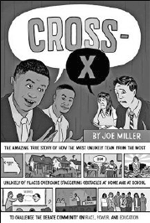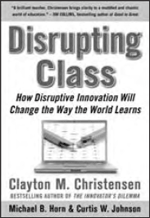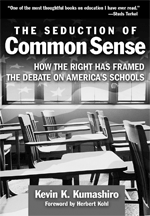 A Whole New Mind: Why Right-Brainers Will Rule the Future
A Whole New Mind: Why Right-Brainers Will Rule the Future
By Daniel H. Pink
Riverside Books, 2006 (Revised edition, paper), $15.00; 275 pages.
As reviewed by Mark Bauerlein
Readers of Education Next have probably observed the oscillation that music, dance, theater, and visual arts teachers suffer in their professional lives. At one pole, they love their material, and recounting what the arts do for young minds sends them into effusive testimonials to the unique powers of their disciplines. At the other pole, they regret the marginal place of the arts in the curriculum. With employers demanding better workplace skills from recent graduates, they say, and No Child Left Behind pushing reading and math, the arts scramble to maintain a foothold in the school week. Those are the dominant themes—a practice that sparks creative and disaffected kids, and a system that shunts it aside.
The situation leaves arts educators ever on the lookout for help. Howard Gardner has bolstered them for decades, his theory of multiple intelligences granting the arts a special role in the education of the whole mind. A few years ago, economist Richard Florida argued that demographic and technological factors have produced a “creative class” of artists, writers, and designers, and also software developers, media entrepreneurs, and hip capitalists. This creative class, he maintained, provides the energy to foster urban renewal and growth. Cities that invested in the arts, bike paths, architecture, etc., thrived throughout the 1990s, and other cities better do the same if they want to survive, Florida warned. Now comes another theorist who has captured the enthusiasm of arts educators. Daniel Pink is a business/technology writer who two years ago proclaimed in “Revenge of the Right Brain” (Wired, February 2005) that a sweeping paradigm shift was under way. Pink phrased it in capital-letter terms: the Information Age of the 1990s rewarded “linear, logical, analytical talents measured by SATs and deployed by CPAs,” but we have entered a new epoch, the Conceptual Age, whose economy runs on “inventive, empathic abilities.” The skills of computing, calculating, diagnostics, and basic legal work are losing their value in the United States. They retain their importance, Pink assures, but any activity that can be reduced to rules and instructions will go into a software program, such as TurboTax®, replacing tax accountants, or end up “migrating across the oceans” to India and China.
The two forces he labels “Asia” and “Automation” have changed the U.S. job market forever, pushing domestic labor into more creative practices. Another one, “Abundance,” adds a consumer factor to the evolution. In the last 30 years, Pink says, wealth has spread and deepened. Life is good, and “the information economy has produced a standard of living that would have been unfathomable in our grandparents’ youth.” With material needs met, people want more than functionality from their goods. They want pleasing aesthetics, and they elevate “less rational sensibilities—beauty, spirituality, emotion.” It’s a Big Idea, this epochal transition from Information Age to Conceptual Age, and the analysis of it could lead into demographic, financial, and geopolitical fields. In A Whole New Mind, Pink tracks it down to a smaller but still central terrain, the individual mind. For the transformations in jobs and goods, he claims, have a complement in the physiology of the brain, and in the styles of cognition that go with it. The Information Age solicits the powers of the left hemisphere, the aptitudes of analysis and numeracy and information management. The Conceptual Age solicits the powers of the right hemisphere, aptitudes of imagination, invention, and empathy. The left side, L-thinking, deals in pieces and series, while R-thinking makes pictures and discerns patterns. L-thinking breaks things down into parts. R-thinking assembles them into wholes. L-thinking conceives things by how they work, R-thinking by how they give pleasure and are meaningful. L-thinking fits a data-oriented economy, R-thinking an idea-oriented one.
That we have entered the latter condition Pink treats as plain. The example of Target stores proves the ascendancy, as it hires world-class designers to provide sleek toilet brushes and cool wastebaskets for budget-conscious consumers. But a problem lingers, he says: Information Age habits and assumptions remain in force. Information Age skills have served so well and yielded so much well-being that people don’t realize the conversion in process.
Pink’s book is an announcement of the turn, and an advice manual. The paradigm shift he takes care of in 60 pages, then devotes six chapters to ways of developing “a whole new mind.” Each chapter covers a new “sense” in a nomenclature that will thrill arts educators: Design, Story, Symphony, Empathy, Play, Meaning. Design adds beauty to function, Story adds drama to argument, Meaning adds, well, meaning to material plenty, etc. Pink supplies concrete tips for joining the movement: “Keep a Design Notebook,” he counsels, and “When you see a great design, make a note of it.” To cultivate empathy, eavesdrop on conversations and try to feel the others’ feelings. To deepen the sense of play, join online communities for gamers, or dissect a joke. Take an acting class, read Powers of Ten by Charles and Ray Eames, and learn to draw on the right side of the brain.
But while the case for arts programs in the Conceptual Age might seem logical, educators should proceed cautiously. For one thing, whether such creative, higher-order skills of the Conceptual Age can prosper without lower-order aptitudes being mastered first is a debatable proposition. I’ve seen too many students being told that “critical thinking” and “meaning-making” activities are the talents they should master, even though they struggle with algebra, misplace commas, and commit basic fallacies. Second, perhaps artistic geniuses can get by without learning to spell or multiply, but the rest better learn the fundamentals. Target isn’t hiring thousands of designers for its goods. It hires “titans such as Karim Rashid and Philippe Starck.” Besides, the outsourcing trend may be exaggerated. For instance, the number of highly skilled industrial jobs in the United States jumped by 36 percent from 1983 to 2002, and cities such as Dubuque, Iowa; Grand Forks, North Dakota; Charleston, South Carolina; and Savannah, Georgia, have become sizzling economies for skilled blue-collar workers (see “The Myth of Deindustrialization,” Wall Street Journal, 6 Aug 2007).
As with any paradigm assertion, larger questions arise, especially in this case, the tempo implied. The Industrial Revolution took decades to happen. The subsequent Industrial Age lasted a couple of centuries before the Digital Revolution arrived 20 years ago. According to Pink, the Information Age has already petered out, at least in the United States. Has the lifetime of ages so contracted that before most people adjust to them they have already ended? Can human beings and human societies change that quickly?
Most of all, are students ready for right-brain conceptualization when only 23 percent of 12th graders reach “proficiency” on the National Assessment of Educational Progress math exam, 35 percent on the reading exam, and 13 percent on the U.S. history exam? For now, keep them on grammar and long division. Ten years from today, A Whole New Mind will join the long list of futurist visions that had its moment and disappeared.
Mark Bauerlein is professor of English and director of the Program in Democracy and Citizenship at Emory University.





